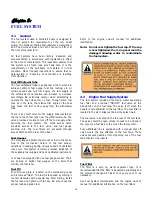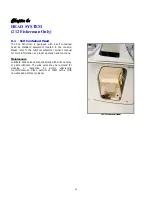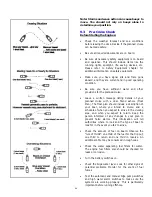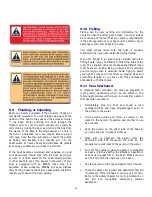
Non-Pyrotechnic Devices
Non-Pyrotechnic visual distress signals must be in
serviceable condition, readily accessible, and certified by
the manufacturer as complying with U.S. Coast Guard
requirements. They include:
•
Orange Distress Flag (Day use only)
The distress flag is a day signal only. It must be at
least 3 x 3 feet with a black square and ball on an
orange background. It is most distinctive when
attached and waved from a paddle or boat hook.
•
Electric Distress Light (Night use only)
The electric distress light is accepted for night use
only and must automatically flash the international
SOS distress signal. Under “Inland Navigation
Rules”, a high intensity white light flashing at regular
intervals from 50-70 times per minute is considered
a distress signal.
Sound Signaling Devices
The navigation rules require sound signals to be made
under certain circumstances. Recreational vessels also
are required to sound fog signals during periods of
reduced visibility. Therefore, you must have some
means of making an efficient sound signal.
Navigation Lights
Recreational boats are required to display navigation
lights between sunset and sunrise and other periods of
reduced visibility (fog, rain, haze, etc). Navigation lights
are intended to keep other vessels informed of your
presence and course. Your boat is equipped with
navigation lights required by the U.S. Coast Guard at the
time of manufacture. It is up to you to make sure they
are operational and turned on when required.
8.3
First Aid
It is the operator’s
responsibility to be familiar
with the proper first-aid
procedures and be able to
care for minor injuries or
illnesses of your passengers.
In an emergency, you could
be far from professional
medical assistance. We
strongly recommend that you be prepared by receiving
training in basic first aid and CPR. This can be done
through classes given by the Red Cross or your local
hospital.
Your boat also should be equipped with at least a simple
marine first-aid kit and a first-aid manual. The marine
first-aid kit should be designed for the marine
environment and be well supplied. It should be
accessible and each person on board should be aware of
its location. As supplies are used, replace them
promptly. Some common drugs and antiseptics may lose
their strength or become unstable as they age. Ask a
medical professional about the supplies you should carry
and the safe shelf life of prescription drugs or other
medical supplies that may be in your first-aid kit.
Replace questionably old supplies whether they have
been used or not.
In many emergency situations, the Coast Guard can
provide assistance in obtaining medical advice for
treatment of serious injuries or illness. If you are within
VHF range of a Coast Guard Station, make the initial
contact on channel 16 and follow their instructions.
8.4
Additional Safety Equipment
Besides meeting the legal requirements, prudent boaters
carry additional safety equipment. This is particularly
important if you operate your boat offshore. You should
consider the following items, depending on how you use
your boat.
Satellite EPIRBS
EPIRBs (Emergency position Indicating Radio Beacon)
operate as part of a worldwide distress system. When
activated, EPIRBs will send distress code homing
beacons that allow Coast Guard aircraft to identify and
find them quickly. The satellites that receive and relay
EPIRB signals are operated by the National Oceanic and
Atmospheric Administration (NOAA) in the United States.
The EPIRB should be mounted and registered according
to the instructions provided with the beacon, so that the
beacon’s unique distress code can be used to quickly
identify the boat and owner.
Marine Radio
A marine radio is the most effective method of receiving
information and requesting assistance. VHF marine
radios are used near shore and single sideband radios
are used for long range communication.
There are specific frequencies to use in an emergency.
The VHF emergency channel is 16 in the United States.
You should read the owners manual for your radio and
know how to use it in an emergency or for normal
operation. If you hear a distress call you should assist or
monitor the situation until help is provided.
Additional Equipment to Consider:
VHF
Radio
Life
Raft
Spare
Anchor
Fenders
Heaving
Line
Mirror
First Aid Kit
Tool Kit
Flashlight & Batteries
Anchor
Searchlight
Boat
Hook
Sunburn
Lotion
Mooring
Lines
Ring
Buoy
Binoculars
Whistle or Horn
Extra Clothing
Portable radio
Chart and Compass
Marine Hardware
Food & Water
Spare
Keys
Sunglasses
Spare
Parts
Spare
Propeller
38
Summary of Contents for 180 Sportsman
Page 2: ...2...
Page 4: ...4...
Page 7: ...180 FISHERMAN SPECIFICATIONS 7...
Page 8: ...180 SPORTSMAN SPECIFICATIONS 8...
Page 9: ...202 FISHERMAN SPECIFICATIONS 9...
Page 10: ...212 FISHERMAN SPECIFICATIONS 10...
Page 18: ...18...
Page 39: ...SAFETY LABELS 2601 1124 39...
Page 40: ...180 FISHERMAN 180 SPORTSMAN CAPACITY LABELS 40...
Page 41: ...202 212 FISHERMAN CAPACITY LABELS 41...
Page 61: ...Appendix A SCHEMATICS 180 FISHERMAN INSTRUMENT PANEL 61...
Page 62: ...Appendix A SCHEMATICS 180 SPORTSMAN INSTRUMENT PANEL 62...
Page 63: ...Appendix A SCHEMATICS 202 212 FISHERMAN INSTRUMENT PANEL 63...
Page 68: ...Appendix A SCHEMATICS 180 FISHERMAN 180 SPORTSMAN TRAILER DRAWING 68...
Page 69: ...Appendix A SCHEMATICS 202 212 FISHERMAN TRAILER DRAWING 69...
Page 70: ...Appendix A SCHEMATICS 180 FISHERMAN OVERHEAD LAYOUT 70...
Page 71: ...Appendix A SCHEMATICS 180 SPORTSMAN OVERHEAD LAYOUT 71...
Page 72: ...Appendix A SCHEMATICS 202 FISHERMAN OVERHEAD LAYOUT 72...
Page 73: ...Appendix A SCHEMATICS 212 FISHERMAN OVERHEAD LAYOUT 73...
Page 77: ...MAINTENANCE LOG 77...
Page 78: ...MAINTENANCE LOG 78...
Page 80: ...Appendix D BOAT ACCIDENT REPORT 80...
Page 81: ...81...
Page 87: ...Appendix F TROUBLESHOOTING GUIDE 87...
Page 88: ...TROUBLESHOOTING GUIDE 88...
Page 89: ...TROUBLESHOOTING GUIDE 89...
Page 90: ...TROUBLESHOOTING GUIDE 90...
Page 91: ...TROUBLESHOOTING GUIDE 91...






























